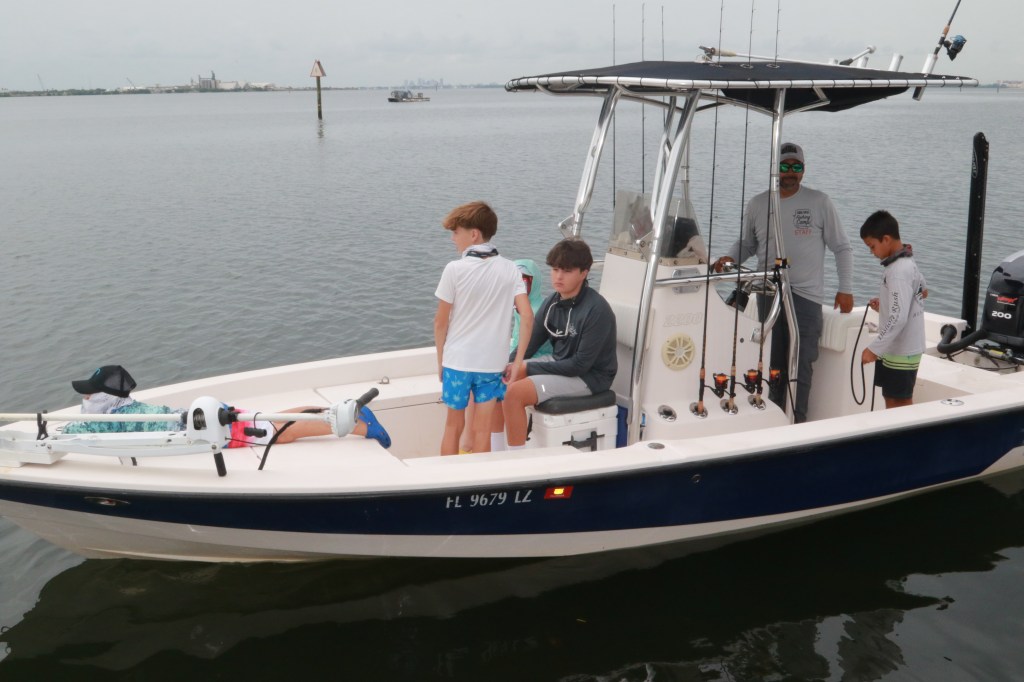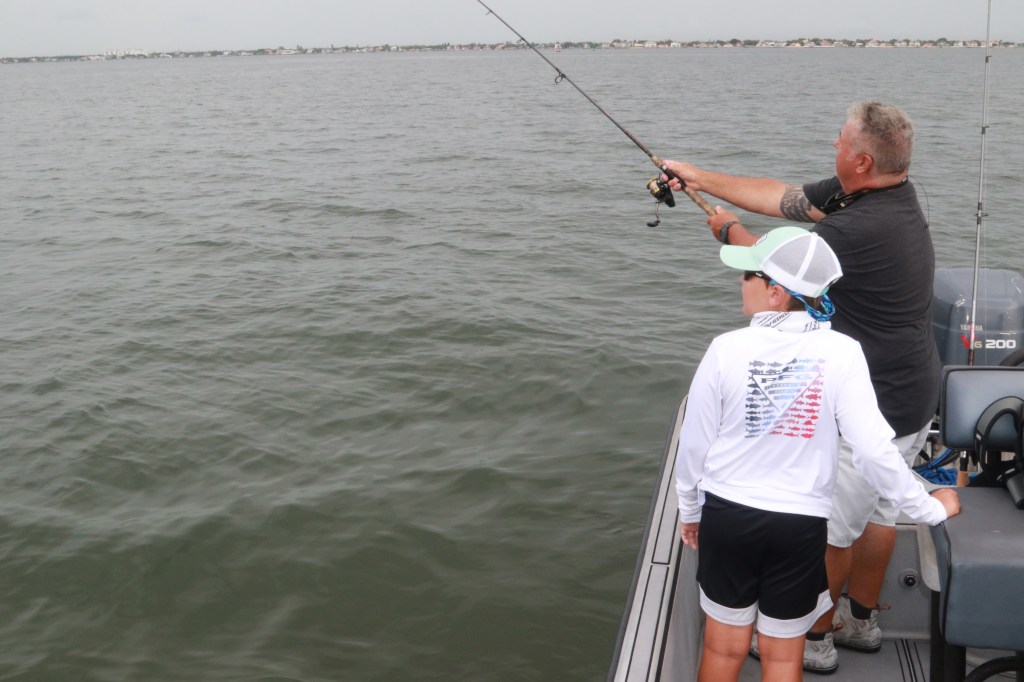
We reached the shallow flat just before daybreak and Capt. Mark Gore’s dry chum quickly did its job. Surface flips, dimples and faint flashes bespoke the gathering baitfish he sought.
A half dozen cast net tosses put plenty of scaled sardines (aka “whitebait”) in his live well and readied him for the crew of young anglers he’d pick up an hour later.

Cast netting is hard work, but Gore puts in the effort just about every day during spring and summer breaks from his job as a safety Guardian with the Hillsborough County School District. Just as he strives to keep the kids at his school safe and happy, Gore seeks to share the natural resources he’s loved all his life with each young angler that steps aboard his 23-foot Sea Pro bay boat.
Commitment and enthusiasm certainly pave the path, but Gore knows the importance of keeping the instruction kid-friendly. Through his private charters and the trips he runs for Florida Fantasy Fishing Camp (https://fantasyfishingcamp.com/), Gore exemplifies important details every adult should consider when teaching kids how to fish.
Species, scenarios, baits, and presentations vary greatly by region, so we’ll stick with broadly applicable principles.

1. Assess angler ability
Before mapping out the day’s objectives, start with an honest discussion of the kid’s fishing experience (if not your own). Parents/guardians can offer insight for hesitant young anglers, but the point is never to minimize — only to properly gauge what a child can handle, while enjoying the experience.
Interest level/attention spans help determine the plan, as some techniques require countless casts and long periods of patience for a potentially eye-popping payoff. Some kids can stare at a float or watch a baited rod longer than many adults, but that’s usually the rarity.
For freshwater pursuits, crickets, live earthworms, or minnows under a red/white bobber offers a relatively easy operation with pretty quick results. In the southern coastal scene, live baiting with sardines, shrimp, and small menhaden (“pogies”) offers plenty of action.
“We use live sardines because they’re easy to fish with and everything eats them,” Gore said. “We might catch snook, trout, redfish, mackerel, jacks, ladyfish, grouper, snapper, or sharks. There’s always something we can target.”

2. Teachable moments
Anglers of any age should trust their guide’s experience and insight. However, many adults charter boats for the learning experience, so don’t deprive kids of the same opportunity.
Gore’s fellow camp guide, Capt. Frankie Diaz said this: “Seeing kids catch their first fish or the biggest fish of their lives is what drives me. Being able to teach them something that they’ll keep for the rest of their lives and pass along to their children is the reward of it.”
Especially when the bite is “on,” we tend to want to rush through the exercise just to put another fish in the boat. All the while, the kids are simply trying to keep up with the hasty instructions and at day’s end, the memory is largely a blur.
Food for thought: Which helps the young angler most, catching a bunch of fish, or understanding how and why a few particular catches occurred?
Rhetorical, but you get the point.

3. Let them fish
Worst thing an adult can do is host a “kids trip” and end up catching most of the fish. Help them with rigging, bait their hooks, help them cast; but when it comes to the most important part — fighting the fish — that’s the memory maker. That’s the mental portal through which all those lessons enter.
During a particularly challenging part of a recent kids trip, I assisted Gore by skipping live sardines under mangrove branches for snook feeding on the falling tide. I hooked a few, but as much as I love this type of fishing, my role was to help the captain’s guests, while he re-rigged a few rods.
There and in other scenarios, I passed a bent rod to a young angler and we all smiled as they reeled in the fish.

4. Correct, don’t criticize
Not a complex point, but one for which adult fishing teachers (including this guy) need constant reminding: This is not a high-stakes tournament; this is not life-and-death — this is all about children opening their hearts and minds to something we hold dear. Do not make them hate this sport by making it too demanding.
Gut check: Impatience does not require words. Sometimes, that huffing and puffing, forehead rubbing, head shaking stuff speaks louder than our voices ever could. Kids may not respond at the moment, but when they decline the next invitation to fish, that outta sting. (Regretfully, I’ve been there.)
Fact: We all learned at some point and most of us probably recall a sharp rebuke that made us wonder if this fishing stuff is really worth it. Yes, learning involves correction, but most children respond much better to encouraging words blended with improvement advice than they do humiliation.

5. Make it fun, keep it safe
Gore often hosts the same camp groups several days in a row, so he’ll work in some unofficial contests to build camaraderie and encourage participation.
“I might tell them ‘Whoever catches the smallest fish has to buy everyone ice cream,’” Gore said. “But then, we get back to the dock and I buy the ice cream.”
Gore’s fellow camp guide, Capt. Ric Liles knows that not every day will offer top-tier species, so he plays up whatever bites. If the more popular fish like snook, trout, and redfish play hard to get, he’ll make up funny nicknames for the B-teamers.
“If one of the kids catches a hardhead catfish, I’ll say, ‘Look, it’s an Australian white belly!’” Liles chuckled.
During a recent Florida Fantasy Fishing Camp trip, Diaz pulled away from the dock with four kids clustered around his center console and one laying prone on his bow. After exiting the idle zone, he’d put everyone in safe running positions, but when he’d stop, the kids could relax as they desired.
The Balance: That’s a good example of letting young anglers enjoy a fishing trip their way, but flexibility must go hand-in-hand with safety. Gore and his fellow camp captains also explain the importance of avoiding accidents.
During a recent summer day, Gore channeled his U.S. Marine Corps background, by reminding his young crew of a critical hot weather precaution: “Okay, while we run to our next spot, everybody grab your water bottles and hydrate — whether you want to or not.”
He also stresses the importance of moving within a boat’s limited space. Dangling lines leave hooks and lures free to grab anything (or anyone) so angles and rod posture must remain front-of-mind.
“Never point a gun at somebody and never point a rod at somebody,” Gore explains. “When we’re all this close, you have to pay attention to your where your rod tip is pointing.”
Other lessons include fish handling for the kids’ safety and that of the fish. Catfish have sharp spines in their fins, snook and snapper are built with sharp gill plates, several saltwater species sport toothy mouths.
“When those kids step onto my boat, they become my responsibility,” Gore said. “My goal is to help them enjoy a fun day on the water and get them back to the dock safely.”

Why it matters
Get this stuff right and many of the kids we teach will want to continue expanding their angling abilities — often with life forming benefit. As Diaz observed, fishing welcomes kids of all backgrounds, abilities, and aptitudes. Some are boisterously “all in,” others need coaxing — all deserve the teacher’s best effort.
“I’ve had kids age out of the (camp) and now, they’re volunteering as camp counselors,” Gore said. “I also have kids that I guided during the camp and they come back with their families to fish with me.”
Practice makes perfect; but patience produces appreciation.
Nothing better than watching a kid catch their first fish — accept, maybe seeing them continue applying the lessons you taught them.




